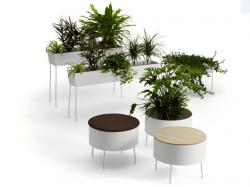OFFECCT Launches OASIS – Added Value Through Greenery
February 8, 2011 | 4 min to read

The focus of OASIS is to add value through a planned use of vegetation in public interiors, and not on the plants themselves. Research has shown that a deliberate use of vegetation in interiors will bring a number of advantages, including an improved indoor environment, an improved air quality, less noise and reduced stress. Green interiors also improve motivation and efficiency at the workplace, resulting in employees and customers feeling more at ease.
“OASIS is one of OFFECCT’s strategically most important investments in recent years. It’s not about the vegetation in itself, but on the added value that green environments creates. In line with our longstanding commitment to creating sustainable design, it was an obvious step to take creating conditions for better indoor climate and a creative work environment," says Kurt Tingdal, CEO, OFFECCT.
The first products coming out of the OASIS concept are designed by four of OFFECCT’s renowned designers.
“We are delighted that the first products resulting from our investment in the OASIS concept was designed by Front, Luca Nichetto, Claesson Koivisto Rune and Jean-Marie Massaud," says Kurt Tingdal.
GREEN PEDESTALS. DESIGNER: FRONT.
Green Pedestals enhances the plants with its elegant legs. Green Pedestals can be used as a room element, that for example functions as a room divider or creates a sort of an oasis. Some variants have dimensions that fits perfectly at the side of a desk, other fits in height next to a seat or a window. It is possible to add a seat or a table top to the round models, and by placing them in a row or in a group they form a sort of a bench that is surrounded by greenery. “We were inspired by traditional pedestals. We think that the pedestal is a fantastic piece of furniture that needs a revival. With slim legs that are slightly irregular Green Pedestals receives a kind of a personality,” says Sofia Lagerkvist, Front.
GREEN TRAYS. DESIGNER: CLAESSON KOIVISTO RUNE.
Claesson Koivisto Rune’s contribution to the concept is Green Trays. Green Trays can be described as a large tray of galvanized steel for the placement of vegetation, and is manufactured in three different sizes.
“In our efforts to develop Green Trays it became clear that there are too few aesthetic and practical pieces of furniture that presents plants in an attractive manner in public interiors," says Eero Koivisto, Claesson Koivisto Rune.
“Our ambition was to design a product that provides space for vegetation in a way so that it becomes possible to integrate greenery in interiors," Eero Koivisto contiues.
GREEN ISLANDS. DESIGNER: JEAN-MARIE MASSAUD.
French designer Jean-Marie Massaud’s contribution the concept is Green Islands. Green Islands can be described as kind of a divan with space for vegetation, and by integrating a higher plant inside Green Islands, a relaxing feeling of sitting as under a tree is created. The key is that the vegetation is part of the furniture. Green Islands can be described as an island – or a kind of a refuge – that when placed in a public interior invite you to a moment of contemplation or a quiet conversation. Green Islands comes in two variants – one circular and one square.
GREEN PADS. DESIGNER: LUCA NICHETTO.
Luca Nichetto – one of Italy’s most promising designers – were inspired by the architecture in the 1950s when he took on the task of producing a product for the OASIS project. In the 1950s, vegetation was an integral part of architecture. As Luca began the development work he put a number of flowers in flowerpots on flowerpot saucers of different sizes next to each other. Then he removed the flowers and the flowerpots but kept the flowerpot saucers on the floor. These flowerpot saucers of various sizes formed a sort of pattern which was then reworked by Luca resulting in the piece of green furniture that has been named Green Pads.
“When I saw the pattern formed by the flowerpot saucers, I thought of Monet’s paintings in Giverny, and I find it hard to imagine a better starting point when designing a product for the OASIS project," says Luca Nichetto.
By combining a number of Green Pads next to each other, a feeling of a single object of greenery is created.
ABOUT OFFECCT
OFFECCT was founded in 1990 by CEO Kurt Tingdal and Design Manager Anders Englund, and is situated in Tibro, Sweden. OFFECCT has 42 people employed with sales of SEK 103 million. More than 50% of the sales are made up of exports to 47 countries.
In 20 years OFFECCT has grown rapidly to become a major furniture manufacturer with high design ambitions, which is particularly evident in the many international design awards that OFFECCT has received over the years. OFFECCT believes that qualitative, innovative and sustainable design creates interiors that have a positive impact on people – in meetings, at home and at work. OFFECCT works closely with some of the world’s most renowned designers.
OFFECCT also believes that sustainability is as important as quality and design, which is evident in the choice of materials, energy, transportation and logistics. Many of OFFECCT’s products have been approved by the Nordic ecolabel, and OFFECCT is also certified in accordance with ISO 9001:2008 (quality) as well as ISO 14001 (environmental).
Several public spaces all over the world have been furnished with objects from OFFECCT. A few examples are the offices of ÅF and the Swedish Association of Architects in Stockholm, the MTV studio in New York, Microsoft in Hong Kong, Philips in Istanbul, MoMA (The Museum of Modern Art) in New York and the Sfera building Restaurant i Kyoto.
Source: OFFECCT
